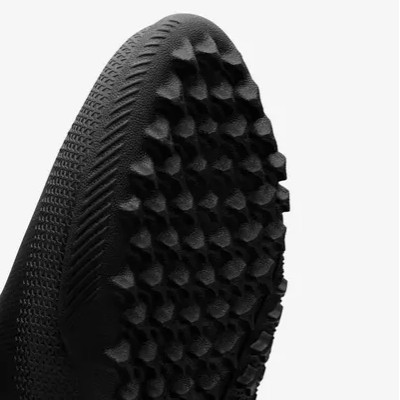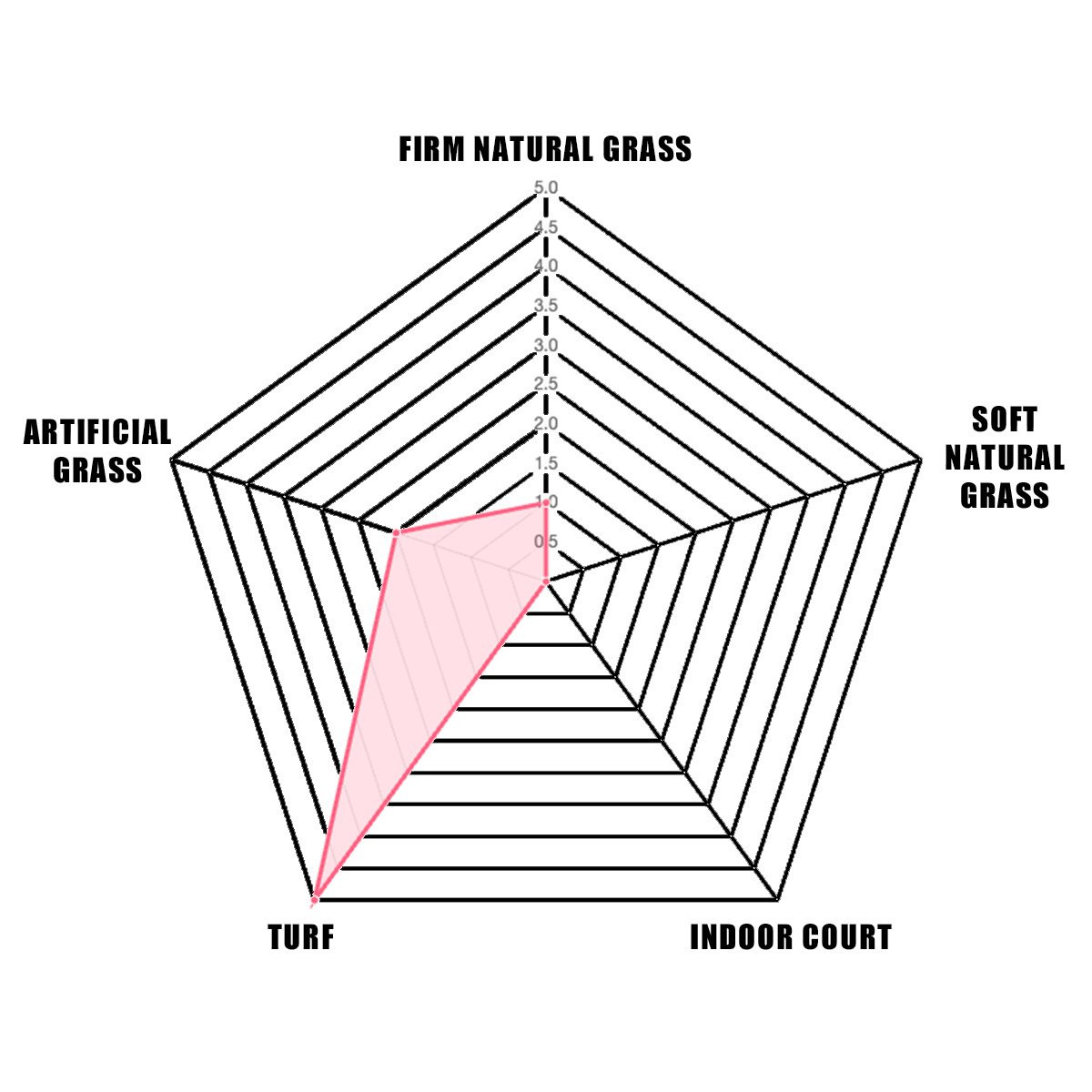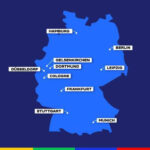Meta Description
Wondering what turf football shoes are and if they’re right for you? CAUHOI2025.UK.COM explains everything you need to know about turf shoes, including their design, benefits, and how they compare to other types of soccer cleats. Get the best gear for your game! Explore artificial turf footwear, soccer trainers, and athletic shoe options.
1. Understanding Turf Football Shoes
Turf football shoes, often called turf cleats or trainers, are specifically designed for playing soccer on artificial turf surfaces. Unlike firm ground (FG) cleats made for natural grass, turf shoes feature a different outsole design optimized for the unique demands of artificial turf.
1.1. What Exactly is Artificial Turf?
Artificial turf has evolved considerably since its initial introduction. Modern artificial turf systems typically consist of synthetic fibers mimicking grass blades, supported by a base of rubber granules or other infill materials. These surfaces offer a consistent playing field regardless of weather conditions, making them a popular choice for soccer fields across the United States.
1.2. Why Can’t I Just Use Regular Cleats?
Using firm ground (FG) cleats on artificial turf can lead to several problems:
- Increased Risk of Injury: FG cleats have longer studs designed to dig into natural grass. On artificial turf, these studs can get caught, increasing the risk of ankle and knee injuries.
- Reduced Traction: The longer studs of FG cleats don’t make full contact with the turf surface, resulting in decreased traction and stability.
- Discomfort: The hard TPU sole plates of FG cleats are not designed for the impact absorption needed on artificial turf, leading to discomfort and fatigue.
- Damage to the Turf: Aggressive cleats can damage the artificial turf fibers, shortening the lifespan of the field.
2. Key Features of Turf Football Shoes
Turf football shoes are designed with features that provide optimal performance and safety on artificial turf:
2.1. Outsole Design
The most distinctive feature of turf shoes is their outsole. Instead of a few long studs, turf shoes have numerous small, rubber studs or patterns. These studs provide:
- Even Pressure Distribution: The high number of studs distributes pressure evenly across the foot, reducing stress on joints.
- Optimal Grip: The rubber studs offer excellent grip on the short, dense fibers of artificial turf, preventing slipping and sliding.
- Enhanced Stability: The wide base of the outsole provides stability, allowing for quick turns and changes of direction.
2.2. Midsole Cushioning
Turf shoes typically feature a cushioned midsole made of EVA foam or similar materials. This cushioning absorbs impact and provides comfort during long practices and games. This is especially important for older players or those prone to joint pain.
2.3. Upper Materials
The uppers of turf shoes are often made from synthetic materials that are durable and weather-resistant. Some models also feature mesh panels for breathability.
2.4. Low Profile Design
Turf shoes generally have a lower profile than FG cleats, bringing the foot closer to the ground for enhanced stability and feel.
 Turf football shoes outsole
Turf football shoes outsole
3. Benefits of Wearing Turf Football Shoes
Using turf football shoes offers several advantages for players who frequently play on artificial turf:
3.1. Reduced Risk of Injury
As mentioned earlier, turf shoes significantly reduce the risk of ankle, knee, and hip injuries compared to FG cleats. The even pressure distribution and enhanced grip minimize the chances of getting studs caught in the turf.
3.2. Improved Performance
The design of turf shoes allows for better traction, stability, and agility on artificial turf. Players can accelerate, decelerate, and change direction more effectively, leading to improved performance.
3.3. Increased Comfort
The cushioned midsole and flexible upper materials of turf shoes provide a comfortable fit, reducing fatigue and allowing players to focus on their game.
3.4. Versatility
While designed primarily for artificial turf, turf shoes can also be used on other hard surfaces, such as indoor courts or concrete. This makes them a versatile option for players who train or play in various environments.
3.5. Longevity
Turf shoes are built to withstand the abrasive nature of artificial turf. Their durable construction ensures they last longer than FG cleats used on the same surface.
4. Types of Artificial Turf
It’s important to understand the different types of artificial turf to choose the right turf shoe.
4.1. First Generation Turf
This type of turf is now outdated, and involves short-pile fibers with sand infill. These fields are hard, and fast.
4.2. Second Generation Turf
A slight improvement of the first, second generation turf included more sand, and some crumb rubber.
4.3. Third Generation Turf
Third generation (3G) turf is the most common type of artificial turf today. It features longer synthetic fibers and a rubber crumb infill. 3G turf mimics the feel of natural grass more closely than previous generations.
4.4. Fourth Generation Turf
Fourth generation (4G) turf eliminates the need for rubber crumb infill, using a denser arrangement of synthetic fibers. This type of turf offers improved traction and a more consistent playing surface.
5. Choosing the Right Turf Football Shoes
Selecting the right turf football shoes depends on several factors:
5.1. Playing Style
Consider your playing style and position. If you’re a fast, agile player, look for lightweight turf shoes with a responsive outsole. If you need more support and stability, choose a model with a wider base and a supportive upper.
5.2. Fit and Comfort
Make sure the shoes fit comfortably and provide adequate support. Try them on with soccer socks and walk around to ensure they don’t cause any rubbing or discomfort.
5.3. Durability
Check the quality of the materials and construction. Look for turf shoes with reinforced stitching and a durable outsole.
5.4. Brand and Price
Consider reputable brands known for producing high-quality soccer footwear. While price is a factor, prioritize quality and performance over cost.
5.5. Reviews and Recommendations
Read online reviews and ask for recommendations from other players or coaches. Their experiences can provide valuable insights into the performance and durability of different turf shoe models.
5.6. Surface Type
Consider that the shoe needs to match the surface as closely as possible. As technology advances, the shoe should follow.
6. Turf vs. Other Types of Football Shoes
It’s helpful to compare turf shoes with other types of soccer cleats to understand their specific applications:
6.1. Turf vs. Firm Ground (FG)
As discussed earlier, FG cleats are designed for natural grass and have longer studs. Turf shoes are specifically for artificial turf and have numerous shorter rubber studs. Using FG cleats on turf can increase the risk of injury and reduce performance.
6.2. Turf vs. Artificial Ground (AG)
Artificial Ground (AG) cleats are designed for newer generations of artificial turf with longer fibers. They feature more studs than FG cleats but fewer than turf shoes. AG cleats can be used on some types of artificial turf but may not provide optimal grip on all surfaces. Some AG shoes can be used on firm ground as well.
6.3. Turf vs. Indoor (IN)
Indoor (IN) shoes have a flat, non-marking outsole designed for indoor courts. They provide excellent grip on hard, flat surfaces but are not suitable for artificial turf or natural grass. They are generally similar to turf shoes in comfort and profile.
6.4. Turf vs. Soft Ground (SG)
Soft Ground (SG) cleats are designed for soft, muddy natural grass fields. They have metal studs that provide maximum grip in wet conditions. SG cleats are not appropriate for artificial turf and should only be used on soft natural grass. They are not very popular in the United States.
 Various types of football shoes
Various types of football shoes
7. Maintaining Your Turf Football Shoes
Proper maintenance can extend the lifespan of your turf football shoes:
7.1. Cleaning
Clean your turf shoes after each use to remove dirt, rubber granules, and other debris. Use a brush or damp cloth to scrub the outsole and upper.
7.2. Drying
Allow your turf shoes to air dry completely after cleaning or playing in wet conditions. Avoid placing them near direct heat, as this can damage the materials.
7.3. Storage
Store your turf shoes in a cool, dry place away from direct sunlight. Use a shoe bag or box to protect them from dust and damage.
7.4. Stud Replacement
If your turf shoes have replaceable studs, check them regularly and replace any worn or damaged studs.
8. The Future of Turf Football Shoe Technology
Turf football shoe technology continues to evolve, with manufacturers constantly innovating to improve performance, comfort, and safety. Some trends to watch include:
8.1. Advanced Materials
New synthetic materials offer improved durability, breathability, and flexibility.
8.2. Innovative Outsole Designs
Manufacturers are experimenting with different stud patterns and shapes to optimize grip and stability on various types of artificial turf.
8.3. Enhanced Cushioning
New cushioning technologies provide better impact absorption and energy return, reducing fatigue and improving comfort.
8.4. Smart Technology
Some turf shoes may incorporate sensors and other smart technologies to track performance metrics and provide feedback to players.
9. Where to Buy Turf Football Shoes in the USA
Turf football shoes are available at a variety of retailers across the United States:
9.1. Sporting Goods Stores
Large sporting goods chains like Dick’s Sporting Goods, Academy Sports + Outdoors, and Soccer.com offer a wide selection of turf shoes from various brands.
9.2. Specialty Soccer Stores
Local soccer specialty stores often have knowledgeable staff who can help you find the right turf shoes for your needs.
9.3. Online Retailers
Online retailers like Amazon, Zappos, and eBay offer a convenient way to shop for turf shoes from the comfort of your home.
9.4. Brand Websites
Many major soccer shoe brands, such as Nike, Adidas, and Puma, sell turf shoes directly through their websites.
10. Expert Advice on Selecting and Using Turf Football Shoes
The expertise of coaches and professionals can provide additional guidance when selecting and using turf shoes.
10.1. Consult Coaches
Seek advice from soccer coaches who have experience with different types of turf and shoe models. Their insights can be invaluable in making the right choice for your playing style and the specific turf conditions you typically encounter.
10.2. Professional Recommendations
Look for recommendations from professional soccer players who have tested and endorsed specific turf shoe models. Their feedback can offer insights into the performance and durability of different options under competitive conditions.
10.3. Attend Workshops
Participate in workshops or clinics led by experts in soccer footwear. These sessions often provide hands-on demonstrations and personalized recommendations to help players understand the nuances of turf shoe technology and selection.
FAQ About Turf Football Shoes
Q1: What is the main difference between turf shoes and cleats?
Turf shoes have many short rubber studs for artificial turf, while cleats have longer studs for natural grass.
Q2: Can I wear turf shoes on natural grass?
Turf shoes are not recommended for natural grass as they may not provide enough traction.
Q3: How often should I replace my turf shoes?
Replace your turf shoes when the studs are worn down, the upper is damaged, or they no longer provide adequate support.
Q4: Are turf shoes suitable for all types of artificial turf?
Turf shoes are generally suitable for most types of artificial turf, but you may need to choose a specific model depending on the length of the fibers and the amount of infill.
Q5: How do I clean my turf shoes?
Clean your turf shoes with a brush or damp cloth after each use and allow them to air dry.
Q6: Can I use turf shoes for running or other sports?
Turf shoes can be used for other activities on hard surfaces, but they are specifically designed for soccer and may not provide optimal performance for other sports.
Q7: What are the best brands for turf football shoes?
Popular brands for turf football shoes include Nike, Adidas, Puma, and New Balance.
Q8: How much do turf football shoes cost?
Turf football shoes range in price from around $40 to $150, depending on the brand, features, and materials.
Q9: Are turf shoes necessary for playing on artificial turf?
While you can technically play on artificial turf with other types of shoes, turf shoes are highly recommended for safety, performance, and comfort.
Q10: Where can I find reviews of turf football shoes?
You can find reviews of turf football shoes on websites like Soccer.com, Amazon, and other sporting goods retailers.
Conclusion: Gear Up for Success on Artificial Turf
Turf football shoes are an essential piece of equipment for any soccer player who frequently plays on artificial turf. By understanding the design, benefits, and types of turf shoes available, you can choose the right pair to maximize your performance, minimize your risk of injury, and enjoy the game to the fullest. At CAUHOI2025.UK.COM, we understand the importance of having reliable information to make informed decisions.
Ready to take your game to the next level? Visit CAUHOI2025.UK.COM today for more expert advice, product reviews, and tips on choosing the right soccer gear. Do you still have questions? Our experts at CauHoi2025.UK.COM are ready to help you. Contact us or visit our “About us” page for more information. Our address is Equitable Life Building, 120 Broadway, New York, NY 10004, USA and our phone number is +1 (800) 555-0199.

